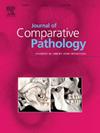Lingual liposarcoma transitioning from an infiltrative lipoma in a dog
IF 0.9
4区 农林科学
Q4 PATHOLOGY
引用次数: 0
Abstract
Lingual neoplasms comprise approximately 2–4 % of canine oropharyngeal tumours, with liposarcomas being particularly rare and typically arising in the subcutis of the extremities and trunk. This report describes a 5-year-old spayed female Bedlington Terrier that presented with a ruptured lingual mass with muscular invasion, for which glossectomy was performed. Histopathological examination revealed a neoplastic proliferation of well-differentiated adipocytes that infiltrated the skeletal muscle layer. The deeper portion of the mass had dedifferentiation of adipocytes and malignant transformation into liposarcoma. The dedifferentiated neoplastic spindle cells contained cytoplasmic lipid vacuoles that stained positively with Oil Red O and had marked pleomorphism and elevated mitotic activity. Immunohistochemically, the neoplastic cells were positive for S100 and negative for CD34. While prior studies have suggested that liposarcomas do not originate from the malignant transformation of lipomas, the findings in this case support the possibility of infiltrative lipoma undergoing malignant transformation into a dedifferentiated and aggressive liposarcoma. This case underscores the potential for benign lipomatous lesions to evolve into their malignant counterparts under certain pathological conditions.
犬舌脂肪肉瘤由浸润性脂肪瘤转变而来
舌部肿瘤约占犬口咽肿瘤的2 - 4%,脂肪肉瘤特别罕见,通常发生在四肢和躯干的皮下。本报告描述了一只5岁的雌性贝德灵顿梗犬,其表现为舌块破裂并肌肉侵入,为此进行了舌骨切除术。组织病理学检查显示肿瘤增生的高分化脂肪细胞浸润骨骼肌层。肿块深部脂肪细胞去分化,恶性转化为脂肪肉瘤。去分化的肿瘤梭形细胞含有油红O染色阳性的细胞质脂泡,具有明显的多形性和升高的有丝分裂活性。免疫组化结果显示,肿瘤细胞S100阳性,CD34阴性。虽然先前的研究表明脂肪肉瘤并非起源于脂肪瘤的恶性转化,但本病例的研究结果支持浸润性脂肪瘤恶性转化为去分化和侵袭性脂肪肉瘤的可能性。本病例强调了良性脂肪瘤病变在某些病理条件下演变为恶性病变的可能性。
本文章由计算机程序翻译,如有差异,请以英文原文为准。
求助全文
约1分钟内获得全文
求助全文
来源期刊
CiteScore
1.60
自引率
0.00%
发文量
208
审稿时长
50 days
期刊介绍:
The Journal of Comparative Pathology is an International, English language, peer-reviewed journal which publishes full length articles, short papers and review articles of high scientific quality on all aspects of the pathology of the diseases of domesticated and other vertebrate animals.
Articles on human diseases are also included if they present features of special interest when viewed against the general background of vertebrate pathology.

 求助内容:
求助内容: 应助结果提醒方式:
应助结果提醒方式:


